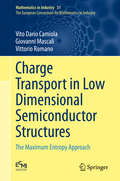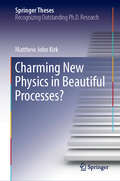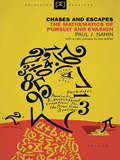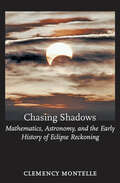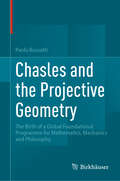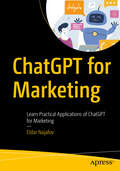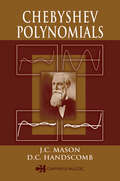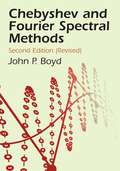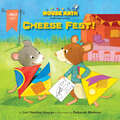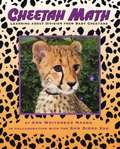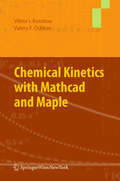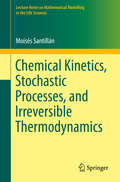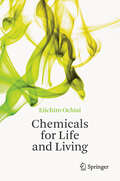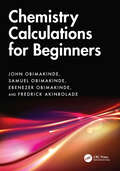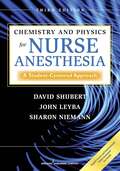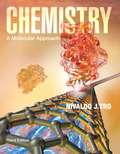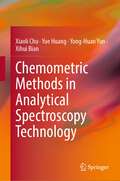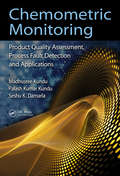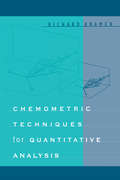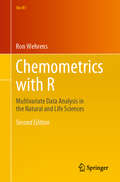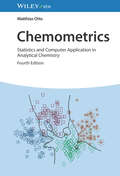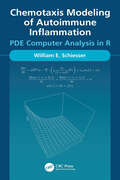- Table View
- List View
Charge Transport in Low Dimensional Semiconductor Structures: The Maximum Entropy Approach (Mathematics in Industry #31)
by Vittorio Romano Vito Dario Camiola Giovanni MascaliThis book offers, from both a theoretical and a computational perspective, an analysis of macroscopic mathematical models for description of charge transport in electronic devices, in particular in the presence of confining effects, such as in the double gate MOSFET. The models are derived from the semiclassical Boltzmann equation by means of the moment method and are closed by resorting to the maximum entropy principle. In the case of confinement, electrons are treated as waves in the confining direction by solving a one-dimensional Schrödinger equation obtaining subbands, while the longitudinal transport of subband electrons is described semiclassically. Limiting energy-transport and drift-diffusion models are also obtained by using suitable scaling procedures. An entire chapter in the book is dedicated to a promising new material like graphene. The models appear to be sound and sufficiently accurate for systematic use in computer-aided design simulators for complex electron devices. The book is addressed to applied mathematicians, physicists, and electronic engineers. It is written for graduate or PhD readers but the opening chapter contains a modicum of semiconductor physics, making it self-consistent and useful also for undergraduate students.
Charm Production in Deep Inelastic Scattering: Mellin Moments of Heavy Flavor Contributions to F2(x,Q^2) at NNLO (Springer Theses)
by Sebastian KleinThe production of heavy quarks in high-energy experiments offers a rich field to study, both experimentally and theoretically. Due to the additional quark mass, the description of these processes in the framework of perturbative QCD is much more demanding than it is for those involving only massless partons. In the last two decades, a large amount of precision data has been collected by the deep inelastic HERA experiment. In order to make full use of these data, a more precise theoretical description of charm quark production in deep inelastic scattering is needed. This work deals with the first calculation of fixed moments of the NNLO heavy flavor corrections to the proton structure function F2 in the limit of a small charm-quark mass. The correct treatment of these terms will allow not only a more precise analysis of the HERA data, but starting from there also a more precise determination of the parton distribution functions and the strong coupling constant, which is an essential input for LHC physics. The complexity of this calculation requires the application and development of technical and mathematical methods, which are also explained here in detail.
Charming New Physics in Beautiful Processes? (Springer Theses)
by Matthew John KirkThis PhD thesis is dedicated to a subfield of elementary particle physics called “Flavour Physics”. The Standard Model of Particle Physics (SM) has been confirmed by thousands of experimental measurements with a high precision. But the SM leaves important questions open, like what is the nature of dark matter or what is the origin of the matter-antimatter asymmetry in the Universe. By comparing high precision Standard Model calculations with extremely precise measurements, one can find the first glimpses of the physics beyond the SM – currently we see the first hints of a potential breakdown of the SM in flavour observables. This can then be compared with purely theoretical considerations about new physics models, known as model building. Both precision calculations and model building are extremely specialised fields and this outstanding thesis contributes significantly to both topics within the field of Flavour Physics and sheds new light on the observed anomalies.
Chases and Escapes
by Paul J. NahinWe all played tag when we were kids. What most of us don't realize is that this simple chase game is in fact an application of pursuit theory, and that the same principles of games like tag, dodgeball, and hide-and-seek are also at play in military strategy, high-seas chases by the Coast Guard, and even romantic pursuits. In Chases and Escapes, Paul Nahin gives us the first complete history of this fascinating area of mathematics, from its classical analytical beginnings to the present day. Drawing on game theory, geometry, linear algebra, target-tracking algorithms, and much more, Nahin also offers an array of challenging puzzles with their historical background and broader applications. Chases and Escapes includes solutions to all problems and provides computer programs that readers can use for their own cutting-edge analysis. Now with a gripping new preface on how the Enola Gay escaped the shock wave from the atomic bomb dropped on Hiroshima, this book will appeal to anyone interested in the mathematics that underlie pursuit and evasion.
Chasing Shadows: Mathematics, Astronomy, and the Early History of Eclipse Reckoning (Johns Hopkins Studies in the History of Mathematics)
by Clemency MontelleLunar and solar eclipses have always fascinated human beings. Digging deep into history, Clemency Montelle examines the ways in which theoretical understanding of eclipses originated and how ancient and medieval cultures shared, developed, and preserved their knowledge of these awe-inspiring events.Eclipses were the celestial phenomena most challenging to understand in the ancient world. Montelle draws on original research—much of it derived from reading primary source material written in Akkadian and Sanskrit, as well as ancient Greek, Latin, and Arabic—to explore how observers in Babylon, the Islamic Near East, Greece, and India developed new astronomical and mathematical techniques to predict and describe the features of eclipses. She identifies the profound scientific discoveries of these four cultures and discusses how the societies exchanged information about eclipses. In constructing this history, Montelle establishes a clear pattern of the transmission of scientific ideas from one culture to another in the ancient and medieval world. Chasing Shadows is an invitingly written and highly informative exploration of the early history of astronomy.
Chasles and the Projective Geometry: The Birth of a Global Foundational Programme for Mathematics, Mechanics and Philosophy
by Paolo BussottiThis monograph meticulously examines the contributions of French mathematician Michel Chasles to 19th-century geometry. Through an in-depth analysis of Chasles' extensive body of work, the author examines six pivotal arguments which collectively reshape the foundations of geometry. Chasles introduces a novel form of polarity, termed "parabolic," to the graphic context, so expressing the metric properties by means of this specific polarity—a foundational argument. Beyond the celebrated "Chasles theorem," he extends his analysis to the movement of a rigid body, employing concepts derived from projective geometry. This approach is consistently applied across diverse domains. Chasles employs the same methodology to analyze systems of forces. The fourth argument examined by the author concerns the principle of virtual velocities, which can also be addressed through a geometric analysis. In the fifth chapter, Chasles' philosophy of duality is explained. It is grounded on theduality principles of projective geometry. Finally, the author presents Chasles’ synthetic solution for the intricate problem of ellipsoid attraction—the sixth and concluding chapter. Throughout these explorations, Chasles engages in a dynamic scientific dialogue with leading physicists and mathematicians of his era, revealing diverse perspectives and nuances inherent in these discussions.Tailored for historians specializing in mathematics and geometry, this monograph also beckons philosophers of mathematics and science, offering profound insights into the philosophical, epistemological, and methodological dimensions of Chasles' groundbreaking contributions. Providing a comprehensive understanding of Chasles' distinctive perspective on 19th-century geometry, this work stands as a valuable resource for scholars and enthusiasts alike.
ChatGPT for Marketing: Learn Practical Applications of ChatGPT for Marketing
by Eldar NajafovExplore the capabilities of ChatGPT and gain insight on how to utilize this AI tool in your daily tasks, and marketing endeavors. This book introduces ChatGPT, covering its architecture, training process, and applications across various fields. Start by delving into the benefits of integrating ChatGPT into everyday routines, emphasizing its potential to streamline tasks, optimize time management, and provide valuable insights that can revolutionize individuals’ work approaches. You'll then look more closely at ChatGPT’s mechanics, its capabilities, limitations, and unique features. The book also outlines the best practices for utilizing ChatGPT, offering practical tips, techniques, and strategies to enhance output quality and reliability, while minimizing errors and maximizing results. You’ll focus on ChatGPT’s relevance in marketing tasks, such as generating product descriptions, creating email templates, automating social media posts, and addressing customer inquiries. The book concludes by exploring techniques for marketing with ChatGPT, including integration with other tools, data analysis, reporting, and customizing ChatGPT to meet specific marketing needs. In the end, you’ll have the knowledge and skills needed to leverage ChatGPT’s AI marketing capabilities and to harness its power for success in the digital age. What You’ll Learn Understand the concepts and workings of ChatGPT, its architecture, and the training process Apply the best practices for ChatGPT Create email templates and automate social media posts using ChatGPT Use ChatGPT for data analysis and reporting Who This Book Is For Marketing professionals, business owners and entrepreneurs, content creators, and customer service representatives
Chebyshev Polynomials
by J.C. Mason David C. HandscombChebyshev polynomials crop up in virtually every area of numerical analysis, and they hold particular importance in recent advances in subjects such as orthogonal polynomials, polynomial approximation, numerical integration, and spectral methods. Yet no book dedicated to Chebyshev polynomials has been published since 1990, and even that work focuse
Chebyshev and Fourier Spectral Methods: Second Revised Edition (Dover Books on Mathematics)
by John P. BoydCompletely revised text focuses on use of spectral methods to solve boundary value, eigenvalue, and time-dependent problems, but also covers Hermite, Laguerre, rational Chebyshev, sinc, and spherical harmonic functions, as well as cardinal functions, linear eigenvalue problems, matrix-solving methods, coordinate transformations, methods for unbounded intervals, spherical and cylindrical geometry, and much more. 7 Appendices. Glossary. Bibliography. Index. Over 160 text figures.
Cheese Fest!: Composing Shapes (Mouse Math)
by Lori Haskins HouranEach read-aloud book in the Mouse Math series focuses on a single, basic math concept and features adorable mice, Albert and Wanda, who live in a People House. Entertaining fiction stories capture kids&’ imaginations as the mice learn about numbers, shapes, sizes and more. Over 3 million copies sold worldwide!Cheese Fest! It&’s every mouse&’s most magical time of the year. This year, Albert and Wanda will even have a booth at the fair . . . once they build it. Albert&’s plans are big, but the cardboard supply is small. How can he make the Cheese Fest booth of his dreams when all he has are a bunch of triangles? Every Mouse Math title focuses on a single basic math concept and includes back matter activities that support and extend reading comprehension and math skills, plus free online activities. (Math concept: Shapes.)
Cheetah Math: Learning About Division from Baby Cheetahs (Animal Math)
by Ann Whitehead Nagda<p>Cheetahs are very fast—and very shy. When two young cubs come to the nursery at the San Diego Zoo, the staff hopes they will help visitors learn more about the plight of cheetahs in the wild. Majani and Kubali are shy, but with the help of their dog buddies they become perfect animal ambassadors. <p>Kids can learn all about division from these baby cheetahs and their canine friends.</p>
Chemical Kinetics with Mathcad and Maple
by Valery Ochkov Viktor KorobovThe authors explain at length the principles of chemical kinetics and approaches to computerized calculations in modern software suites -- mathcad and maple. Mathematics is crucial in determining correlations in chemical processes and requires various numerical approaches. Often significant issues with mathematical formalizations of chemical problems arise and many kinetic problems can´t be solved without computers. Numerous problems encountered in solving kinetics´ calculations with detailed descriptions of the numerical tools are given. Special attention is given to electrochemical reactions, which fills a gap in existing texts not covering this topic in detail. The material demonstrates how these suites provide quick and precise behavior predictions for a system over time (for postulated mechanisms).Examples, i.e., oscillating and non-isothermal reactions, help explain the use of mathcad more efficiently. Also included are the results of authors' own research toward effective computations.
Chemical Kinetics, Stochastic Processes, and Irreversible Thermodynamics (Lecture Notes on Mathematical Modelling in the Life Sciences)
by Moisés SantillánThis book brings theories in nonlinear dynamics, stochastic processes, irreversible thermodynamics, physical chemistry and biochemistry together in an introductory but formal and comprehensive manner Coupled with examples, the theories are developed stepwise, starting with the simplest concepts and building upon them into a more general framework Furthermore, each new mathematical derivation is immediately applied to one or more biological systems The last chapters focus on applying mathematical and physical techniques to study systems such as: gene regulatory networks and molecular motors. The target audience of this book are mainly final year undergraduate and graduate students with a solid mathematical background (physicists, mathematicians and engineers), as well as with basic notions of biochemistry and cellular biology. This book can also be useful to students with a biological background who are interested in mathematical modeling and have a working knowledge of calculus, differential equations and a basic understanding of probability theory.
Chemicals for Life and Living
by Eiichiro OchiaiChemicals often have a negative Image among the general public. But there is no material world or indeed human beings without chemicals. The material world is operated by chemicals. The title 'Chemicals for Life and Living' implies that the material world is staged and played by chemicals. The book consists of five parts and an appendix. Part 1 - Essentials for life; Part 2 - Enhancing health; Part 3 - For the fun of life; Part 4 - Chemistry of the universe and earth, and Part 5 - Some negative effects of chemicals. The appendix gives a brief summary of what chemistry is all about, including a short chapter of chemical principles. No quantitative calculations are included in this book so that it is appealing for everyone - not just chemists.
Chemistry Calculations for Beginners
by John Obimakinde Samuel Obimakinde Ebenezer Obimakinde Fredrick AkinboladeWith decades of combined experience as science teachers at both school and undergraduate levels, the authors have recognised that one of the greatest challenges faced by students studying chemistry is grasping the complexity of the numerous numerical problems found in most parts of the subject. This text is crafted to provide a clear and accessible pathway to overcoming this challenge by assisting students, especially novices or those with minimal knowledge of the subject, in performing chemistry calculations. The content covers fundamental calculations crucial to understanding the principles of chemistry, making it an invaluable tool for students aiming to excel in their studies.Key features Designed with a student-friendly approach, including detailed explanation of chemical concepts underlying each type of calculation, step-by-step explanations, alternative methods for solving problems, numerous practice exercises, answers to practice exercises and appendices The book is tailored to suit various curricula, ensuring relevance for a diverse audience Encompasses a wide range of calculations, offering students a thorough understanding of essential chemistry concepts Serves as an excellent resource for exam preparation and equips students with skills applicable to future scientific endeavours. Employs straightforward language to ensure ease of understanding for beginners Uses IUPAC conventions, underscoring the universal nature of chemistry
Chemistry and Physics for Nurse Anesthesia: A Student-Centered Approach
by David Shubert John Leyba Sharon NiemannWith a focus on chemistry and physics content that is directly relevant to the practice of anesthesia, this text--written in an engaging, conversational style--supplies all the scientific information required for the combined chemistry and physics course for nurse anesthesia students. Now in its third edition, the text is updated and reorganized to facilitate a greater ease and depth of understanding. The addition of a third author--a practicing nurse anesthetist--enhances the clinical relevance of the scientific information. Clinical scenarios now begin every chapter, and a concluding chapter, new to this edition, provides detailed, step-by-step solutions to the book's review questions. Also included is a comprehensive list of need-to-know equations. <P><P>The third edition retains the many outstanding learning features from earlier editions, including a special focus on gases, the use of illustrations to demonstrate how scientific concepts relate directly to their clinical application in anesthesia, and end-of-chapter summaries and review questions to facilitate self-assessment. Fifteen online videos enhance teaching and learning, and abundant clinical application scenarios help reinforce scientific principles and relate them to day-to-day anesthesia procedures. This clear, easy-to-read text will help even the most chemistry- and physics-phobic students to master the foundations of these sciences and competently apply them in a variety of clinical situations.
Chemistry for Engineering Students: Student Solutions and Study Guide
by Lawrence S. Brown Thomas A. Holme Steve RathboneThe STUDENT SOLUTIONS MANUAL AND STUDY GUIDE provides students with a comprehensive guide to working the solutions to the odd-numbered end-of-chapter problems in the text and also includes each chapter's Study Goals and Chapter Objective quizzes. Because the best way for students to learn and understand the concepts is to work multiple, relevant problems on a daily basis and to have reinforcement of important topics and concepts from the book, the STUDENT SOLUTIONS MANUAL gives students instant feedback by providing not only the answers to problems, but also detailed explanations of each problem's solution.
Chemistry: A Molecular Approach, 3rd Edition
by Nivaldo J. TroChemistry: A Molecular Approach, Third Edition is an innovative, pedagogically driven text that explains challenging concepts in a student-oriented manner. Nivaldo Tro creates a rigorous and accessible treatment of general chemistry in the context of relevance and the big picture. Chemistry is presented visually through multi-level images-macroscopic, molecular, and symbolic representations-helping students see the connections between the world they see around them (macroscopic), the atoms and molecules that compose the world (molecular), and the formulas they write down on paper (symbolic). The hallmarks of Dr. Tro's problem-solving approach are reinforced through interactive media that provide students with an office-hour type of environment built around worked examples and expanded coverage on the latest developments in chemistry. Pioneering features allow students to sketch their ideas through new problems, and much more.
Chemometric Methods in Analytical Spectroscopy Technology
by Xiaoli Chu Yue Huang Yong-Huan Yun Xihui BianThis book discusses chemometric methods for spectroscopy analysis including NIR, MIR, Raman, NMR, and LIBS, from the perspective of practical applied spectroscopy. It covers all aspects of chemometrics associated with analytical spectroscopy, including representative sample selection algorithm, outlier detection algorithm, model updating and maintenance algorithm and strategy and calibration performance evaluation methods.To provide a systematic and comprehensive overview the latest progress of chemometric methods including recent scientific research and practical applications are presented. In addition the book also highlights the improvement of classical algorithms and the extension of common strategies. It is therefore useful as a reference book for researchers engaged in analytical spectroscopy technology, chemometrics, analytical instruments and other related fields.
Chemometric Monitoring: Product Quality Assessment, Process Fault Detection, and Applications
by Madhusree Kundu Palash Kumar Kundu Seshu K. DamarlaData collection, compression, storage, and interpretation have become mature technologies over the years. Extraction of meaningful information from the process historical database seems to be a natural and logical choice. In view of this, the proposed book aims to apply the data driven knowledge base in ensuring safe process operation through timely detection of process abnormal and normal operating conditions, assuring product quality and analyzing biomedical signal leading to diagnostic tools. The book poses an open invitation for an interface which is required henceforth, in practical implementation of the propositions and possibilities referred in the book. It poses a challenge to the researchers in academia towards the development of more sophisticated algorithms. The proposed book also incites applications in diversified areas. Key Features: Presents discussion of several modern and popular chemometric techniques Introduces specific illustrative industrial applications using the chemometric techniques Demonstrates several applications to beverage quality monitoring Provides all the algorithms developed for the automated device design, data files, sources for biomedical signals and their pre-processing steps, and all the process models requited to simulate process normal/faulty data Includes casestudy-based approach to the topics with MATLAB and SIMULINK source codes
Chemometric Techniques for Quantitative Analysis
by Richard KramerChemometric Techniques for Quantitative Analysis shows how to produce and use quantitative analytical calibrations in a laboratory or production environment following a variety of methods, how to estimate the time and resources needed to develop analytical calibrations, and how to employ the quantitative software provided with a wide range of instr
Chemometrics with R: Multivariate Data Analysis in the Natural and Life Sciences (Use R!)
by Ron WehrensThis book offers readers an accessible introduction to the world of multivariate statistics in the life sciences, providing a comprehensive description of the general data analysis paradigm, from exploratory analysis (principal component analysis, self-organizing maps and clustering) to modeling (classification, regression) and validation (including variable selection). It also includes a special section discussing several more specific topics in the area of chemometrics, such as outlier detection, and biomarker identification. The corresponding R code is provided for all the examples in the book; and scripts, functions and data are available in a separate R package. This second revised edition features not only updates on many of the topics covered, but also several sections of new material (e.g., on handling missing values in PCA, multivariate process monitoring and batch correction).
Chemometrics: Statistics and Computer Application in Analytical Chemistry
by Matthias OttoChemometrics Explore chemometrics from basic statistics to the latest artificial intelligence and neural network developments in this new edition Chemometrics is an area of study combining chemistry and mathematics. It governs the interpretation of data generated by chemical analysis, and its growth as a subfield promises to streamline and revolutionize analytical chemistry. Chemometrics has long been the leading introductory textbook in this subject. Beginning with an introduction to the statistical-mathematical evaluation of chemical measurements, it leads readers through modern chemometric approaches in a pedagogically sound and highly readable style. Now fully updated to reflect the latest research and applications of this exciting discipline, it provides essential tools for a new generation of analytical chemists. Readers of the fourth edition of Chemometrics will also find: New or expanded treatment of subjects such as deep learning, ANNOVA simultaneous component analysis, instrumental data output, and more Detailed discussion of approaches to signal processing, design and optimization of experiments, pattern recognition and classification, and many other areas Balance of theoretical and practical knowledge to enable rapid application of key techniques Chemometrics is ideal for advanced students in chemistry, analytical chemistry, pharmaceutical chemistry, biochemistry, or related subjects, and as a useful reference for practicing researchers and laboratory professionals.
Chemotaxis Modeling of Autoimmune Inflammation: PDE Computer Analysis in R
by William SchiesserIn response to an infection (e.g., from pathogens such as bacteria and viruses), the immune system can deplete macrophages (specialized white blood cells) and produce cytokines that are pro-inflammatory or anti-inflammatory. This counterproductive autoimmune response is represented mathematically as nonlinear chemotaxis diffusion. This book is directed to the computer-based modeling of chemotaxis inflammation. The spatiotemporal analysis is based on a model of three partial differential equations (PDEs). The three PDE model is coded (programmed) as a set of routines in R, a quality, open-source, scientific programming system. The numerical integration (solution) of the PDEs is by the method of lines (MOL). The three PDE model can be used for computer-based experimentation, for example, parameter variation and changes in the model equations or alternate models, to enhance a quantitative understanding of a postulated inflammation. This experimentation is illustrated by chapters pertaining to: (1) the computation and display of the PDE time derivatives, (2) the RHS terms of the PDEs with emphasis on the chemotaxis terms, (3) parameter variations to demonstrate parameter effects and sensitivities and (4) additonal terms in the PDEs to include PDE coupling and extensions of the basic PDE model.
Chi-squared Goodness-of-fit Tests for Censored Data
by Ekaterina V. Chimitova Mikhail S. NikulinThis book is devoted to the problems of construction and application of chi-squared goodness-of-fit tests for complete and censored data. Classical chi-squared tests assume that unknown distribution parameters are estimated using grouped data, but in practice this assumption is often forgotten. In this book, we consider modified chi-squared tests, which do not suffer from such a drawback. The authors provide examples of chi-squared tests for various distributions widely used in practice, and also consider chi-squared tests for the parametric proportional hazards model and accelerated failure time model, which are widely used in reliability and survival analysis. Particular attention is paid to the choice of grouping intervals and simulations. This book covers recent innovations in the field as well as important results previously only published in Russian. Chi-squared tests are compared with other goodness-of-fit tests (such as the Cramer-von Mises-Smirnov, Anderson-Darling and Zhang tests) in terms of power when testing close competing hypotheses.
